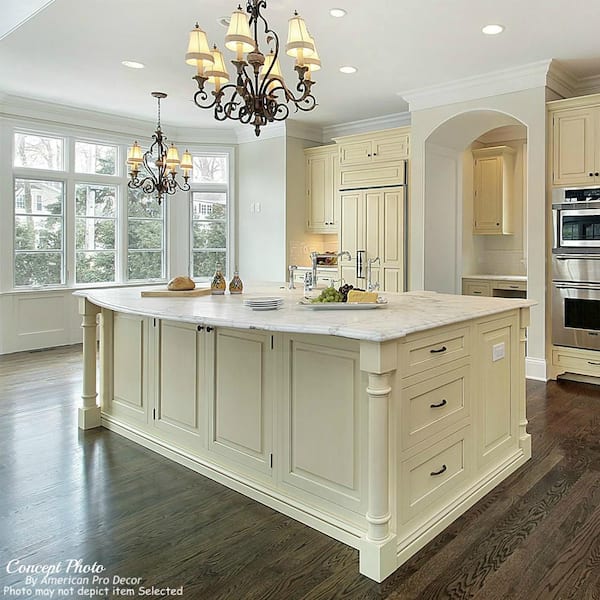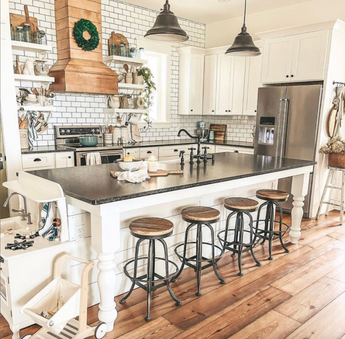An Overview to Picking the Perfect Kitchen Island for Your Home
Selecting the best kitchen area island is a multi-faceted choice that can dramatically affect both the performance and aesthetics of your home. Comprehending your kitchen's spatial characteristics is the initial step, making certain that the island fits flawlessly without interrupting the circulation. Beyond room considerations, identifying the key function of the island-- be it for meal preparation, eating, or added storage-- is critical. The option of finishes and materials additionally plays a crucial function in harmonizing the island with your cooking area's total design. As we discover these components further, the nuances of each choice will become clear.
Evaluating Your Room
Prior to picking a kitchen island, it is vital to extensively evaluate your space to guarantee the addition will be both functional and aesthetically pleasing. Begin by measuring the offered location, including the size, size, and elevation of the kitchen area. Exact dimensions are critical to stay clear of buying an island that overwhelms the space or one that is overmuch little.
Think about the existing layout and exactly how the island will certainly incorporate with the existing website traffic circulation. A well-placed island needs to not impede or obstruct paths access to vital appliances, such as the stove, sink, and refrigerator. Leave ample clearance space-- usually around 36 to 48 inches on all sides-- to enable comfortable motion and work area performance.
Next, assess the natural light and sightlines within your kitchen area. An island that blocks a home window or interrupts aesthetic cohesion can make the room feel dark and cramped. Think of how the island's positioning will influence lights and presence, ensuring it enhances instead of detracts from the kitchen's atmosphere.
Determining the Function
Figuring out the objective of your kitchen area island is a crucial action in ensuring it satisfies your certain requirements and choices. Before diving right into style or dimension considerations, it is vital to clarify what key feature the island will certainly serve in your kitchen area. Will it be a central center for meal preparation, a laid-back dining area, or possibly an additional storage remedy?
Furthermore, sufficient counter area for blending and cutting, along with easily accessible storage space for kitchen area tools and ingredients, can transform the island right into an efficient workstation. Alternatively, if the island is meant to promote social interactions or serve as an eating location, seating plans become extremely important.

Choosing the Right Size
Selecting the best dimension for your cooking area island is a balance of capability and room optimization. An excellent kitchen island must give adequate work area while guaranteeing that activity around the cooking area continues to be unblocked. Begin by gauging your kitchen area area; the original source a minimum clearance of 36 to 42 inches around the island is needed to permit comfortable activity and ease of access.
The dimensions of the island need to show its designated use. If the island will certainly offer mostly as a prep area, a size of 24 to 36 inches could be enough.

Last but not least, guarantee that the island's size enhances the overall kitchen layout, staying clear of any type of frustrating visibility that could interfere with the kitchen's visual and energy - kitchen island legs. Careful preparation and exact dimensions will help you accomplish a efficient and harmonious cooking area setting
Picking Materials and Finishes
After figuring out the appropriate dimension for your kitchen area island, the following step includes choosing suitable products and coatings. The option of materials substantially influences both the visual charm and performance of your cooking area island. Popular materials for kitchen counters include granite, butcher, and quartz block, each offering distinct advantages.
Along with the counter top, take into consideration the materials for the island base. Strong timber provides a traditional, strong look, while stainless-steel gives a streamlined, modern-day look and is very easy to tidy. Repainted coatings can introduce a sprinkle of shade, with alternatives ranging from soft pastels to bold, lively hues.
Pay focus to the toughness of surfaces, especially in high-traffic areas, to keep the island's appearance over time. Selecting the best materials and coatings will boost both the functionality and visual charm of your kitchen area island.
Incorporating Useful Features
Incorporating practical features right into your kitchen area island can substantially improve its energy and convenience, transforming it right into a versatile centerpiece of your cooking area. One crucial attribute to take into consideration is extra storage. Integrating closets, cabinets, and open shelving can offer much-needed area for cookware, utensils, and little home appliances, assisting to keep a clutter-free setting.
Another valuable enhancement is a built-in sink or cooktop, which can improve meal prep work and clean-up processes. A sink can assist in tasks such as cleaning veggies and cleansing recipes, while a cooktop can permit cooking directly on the island, fostering a more interactive and social cooking experience.
Think about incorporating seating alternatives, especially if your cooking area functions as an informal dining location. Bar stools or integrated benches can transform the island right into a multifunctional area for dishes, research, or informal gatherings.
Lastly, integrating electrical outlets Discover More into your cooking area island can enhance its usefulness. Electrical outlets provide practical accessibility for little kitchen devices, billing stations for electronic tools, and extra lighting alternatives.
Conclusion

Before picking a cooking area island, it is important to extensively assess your area to make sure the addition will certainly be both functional and cosmetically pleasing.Selecting the ideal size for your cooking area island is a balance of capability and area optimization. kitchen island legs. A suitable cooking area island must give enough work space while ensuring that movement around the cooking area continues to be unblocked.Integrating functional functions into your kitchen area island can substantially boost its energy and ease, transforming it into a flexible centerpiece of your cooking area.In final thought, picking the suitable kitchen island requires a comprehensive assessment of the readily available space, clarity regarding its primary function, and cautious consideration of the appropriate dimension and products